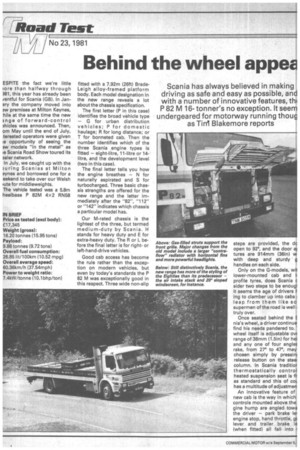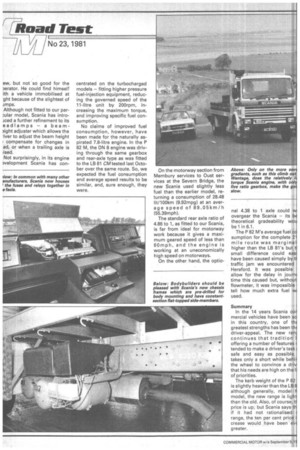Behind the wheel appea
Page 30

Page 31

Page 32

If you've noticed an error in this article please click here to report it so we can fix it.
Scania has always believed in making driving as safe and easy as possible, and with a number of innovative features, thi P82 M 16tanner's no exception. It seem undergeared for motorway running thoug as Tins Blakemore reports
ESPITE the fact we're little tore than halfway through )81, this year has already been ventful for Scania (GB). In Janary the company moved into aw premises at Milton Keynes, hile at the same time the new Inge of forward-control thicles was announced. Then, om May until the end of July, terested operators were given re opportunity of seeing the 9w models "in the metal" as re Scania Road Show toured its aaler network.
In July, we caught up with the auring Scanias at Milton aynes and borrowed one for a eekend to take over our Welsh lute for middleweights.
The vehicle tested was a 5,8m heelbase P 82M 4x2 RN58 IN BRIEF Price as tested (excl body): £17,345 Weight (gross): 16.20 tonnes (15.95 tons) Payload: 9.88 tonnes (9.72 tons) Overall fuel consumption: 26.85 lit/100km (10.52 mpg) Overall average speed: 60.36km/h (37.54mph I Power to weight ratio: 7.4kW/tonne (10.1bhp/ton) fitted with a 7.92m (26ft) BradeLeigh alloy-framed platform body. Each model designation in the new range reveals a lot about the chassis specification.
The first letter (P in this case) identifies the broad vehicle type — G for urban distribution vehicles; P for domestic haulage; R for long distance; or T for bonneted cab. Then the number identifies which of the three Scania engine types is fitted — eight-litre, 11-litre or 14litre, and the development level (two in this case).
The final letter tells you how the engine breathes — N for naturally aspirated and S for turbocharged. Three basic chassis strengths are offered for the new range and the letter immediately after the "82", "112" or "142" indicates which chassis a particular model has.
Our M-rated chassis is the lightest of the three, but termed medium-duty by Scania. H stands for heavy duty and E for extra-heavy duty. The R or L before the final letter is for rightor left-hand-drive vehicles.
Good cab access has become the rule rather than the exception on modern vehicles, but even by today's standards the P 82 M was exceptionally good in this respect. Three wide non-slip
steps are provided, the dc open to 920, and the door al tures are 914mm (36in) w with deep and sturdy g handles on each side.
Only on the G-models, wil lower-mounted cab and I. profile tyres, does Scania c sider two steps to be enougl it seems the age of drivers ing to clamber up into cabs . leap from them like so supermen of the road is well truly over.
Once seated behind the nia's wheel, a driver continue find his needs pandered to.. wheel itself is adjustable ov( range of 38mm (1.5in) for hei and any one of four angles rake, from 27° to 47°, may chosen simply by pressini release button on the steel column. In Scania traditior thermostatically control heated suspension seat is as standard and this of coi. has a multitude of adjustmen An innovative feature of new cab is the way in which controls mounted above the gine hump are angled towa the driver — park brake le+ engine stop, hand throttle, g€ lever and trailer brake le (when fitted) all fall into 1
egory. The angle is small and first there seemed no difance, but as the day's testing re on I began to appreciate t canting these controls tords the driver's seat does ke the operation easier. In ticular, the park brake lever ;ition is a vast improvement )rthe LB 81 component, ich is awkward to apply.
Il the Scania's controls have positive feel about them, -haps best described as being the action of a good Jape3e camera. If the vehicle had 3n specially prepared for the t, then the ultra-smooth funcling of the controls could -haps be attributed to careful Iparation; but this lorry was t a "normal" demonstration .ricle so this characteristic is rly to be typical of the new ;rile breed. On the throttle 1 gearchange rods, low fric
▪ linkages are responsible for reducing driver effort to a minimum.
Some drivers, however, may regard the degree of power assistance for the steering as too great, and on our fully laden 16tonner it really was a matter of fingertip control at all speeds. If the wheel was gripped too tightly, there was a tendency to see-saw about the straightahead position.
Compared with the LB Si Scania we tested last October, the ratio of the steering box is the same, but turning circles have been improved — 19.40m (63ft
8in) kerb to kerb on left lock, as against 26.6m (71ft) for the previous model.
The heating and ventilation system in the Scania cab has been comprehensively re-designed and now has a glass wool filter, which, it is claimed, is fine enough to filter out pollen from air entering the cab — obviously a boon for drivers with hay fever.
Ambient temperatures as low as —30°C can be catered for by the powerful heater, Scania claims. I can't vouch for that as even in July in Britain temperatures don't fall that low, butt can confirm the effectiveness of the face-level fresh-air vents which were a notable omission on the LB 81.
Side-window misting won't be a problem either on the new Scanias as the demister trunkinl is connected to ducts in thr doors. Instead of heating thr rear of the cab, the amount o heated air directed to the sicir windows can be controlled br means of flaps at the rear of Or arm rests.
An electrically operated pas senger window is standard or the P 82. Like DAF, Scania wiselr provides a means of operatinE the window mechanically in thE event of an electrical fault. ThE motor is readily accessible or the inside of the passenger door and when its cover is removed, E socket and spanner can easily bE applied to the window windel spindle.
The rear-view mirrors fitted tc this new Scania are taller anc more convex than most, givinc an unusually wide field of visior to the rear. For greater safety a' night, the latest headlamps haw a wider angle of beam, and z light output intensified by 30 pei cent, says Scania — the old cir. cular type were often criticisec for being too dim.
The headlight, mounting it linked to the cab's front mounting, so that the beams are unaffected by cab movements. Other manufacturers have avoided this problem with suspended cabs by fitting their lights in the fron1 bumper — an adequate solution from a manufacturer's point oi
ew, but not .so good for the aerator. He could find himself ith a vehicle immobilised at ght because of the slightest of imps.
Although not fitted to our parAltar model, Scania has introiced a further refinement to its eadlamps — a beameight adjuster which allows the -iyer to adjust the beam height
compensate for changes in ad, or when a trailing axle is used.
Not surprisingly, in its engine avelopment Scania has con centrated on the turbocharged models — fitting higher pressure fuel-injection equipment, reducing the governed speed of the 11-litre unit by 200rpm, increasing the maximum torque, and improving specific fuel consumption.
No claims of improved fuel consumption, however, have been made for the naturally aspirated 7.8-litre engine, In the P 82 M, the DN 8 engine was driving through the same gearbox and rear-axle type as was fitted to the LB 81 CM tested last October over the same route. So, we expected the fuel consumption and average speed results to be similar, and, sure enough, they were. On the motorway section from Membury services to Oust services at the Severn Bridge, the new Scania used slightly less fuel than the earlier model, returning a consumption of 28.48 lit/100km (9.92mpg) at an average speed of 8 9.0 5km/h (55.39mph).
The standard rear axle ratio of 4.86 to 1, as fitted to our Scania, is far from ideal for motorway work because it gives a maximum geared speed of less than 60mph, and the engine is working at an uneconomically high speed on motorways.
On the other hand, the optio
nal 4.38 to 1 axle could Int overgear the Scania — its bE theoretical gradeability wou be 1 in 6.1.
The P 82 M's average fuel co sumption for the complete 21 mile route was marginal higher than the LB 81's but tl small difference could easi have been caused simply by ti traffic jam we encountered Hereford. It was possible allow for the delay in journi time this caused but, without flowmeter, it was impossible tell how much extra fuel w. used.
Summary In the 14 years Scania cor mercial vehicles have been so in this country, one of thE greatest strengths has been thE driver-appeal. The new ram continues that tradition offering a number of features i tended to make a driver's task . safe and easy as possible. takes only a short while behir the wheel to convince a driv that his needs are high on the Ii of priorities.
The kerb weight of the P 82 is slightly heavier than the LB 8 although generally, model f model, the new range is light than the old. Also, of course, a price is up; but Scania says th if it had not rationalised i range, the ten per cent price i crease would have been evf greater.








































